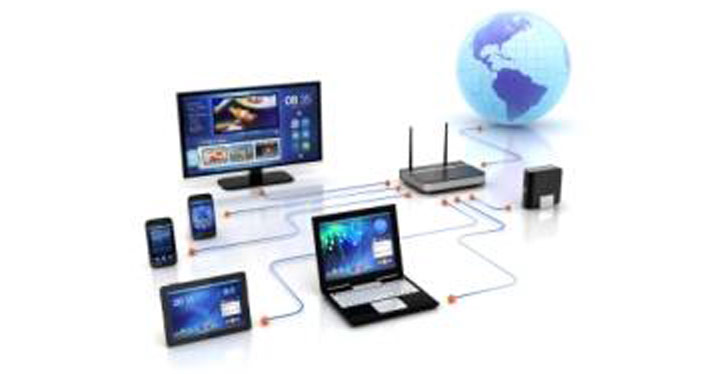I. Introduction
IEEE standards play a role from smart cities to smart devices. Our standards drive “the functionality, capabilities and interoperability of a wide range of products and services that transform the way people live, work and communicate.” [1] What does smart mean? There is no standard definition. In my opinion, the required functions include external environment sensing, internal processing, memory, data analysis, and external action and/or output. IEEE has standards covering all of these functions, but it is where these functions are distributed among different devices that IEEE standards for communications networks and their protocols become critical for interoperability and transmission of information between different devices and people.
Examples
For the infrastructure of smart cities, communications is key to:
- The management of utilities such as the smart grid as described in IEEE 2030-2011-IEEE Guide for Smart Grid Interoperability of Energy Technology and Information Technology Operation with the Electric Power System (EPS), end-use applications, and loads;
- Education (within schools, remotely, and in MOOCs (massively open online courses));
- E-government between officials and citizens including access to open data;
- Telemedicine;
- Management of traffic and transit systems;
- Law enforcement.
For smart commercial buildings and factories, communications is key to:
- Business operations, energy management, and automated factory processes.
For smart homes, communications is key to:
- Energy management (e.g. for smart appliances) and connection of home entertainment and security systems.
For smart vehicles, communications is key to:
- Automated driver assistance systems (ADAS) (for safety or convenience), and receipt/transmission of information and entertainment.
For smart devices, communications is key to:
- Wearable health devices;
- Cell phones, tablets, etc.
Within the large set of IEEE communications standards, IEEE 802 standards are foundational to the applications mentioned previously, and provide connectivity for connected city infrastructure; connected commercial buildings; connected homes; connected vehicles; and connected people.
II. IEEE 802.3, IEEE 802.11, IEEE 802.15.4, and IEEE 802.15.1
Four of the most well-used IEEE 802 standards are IEEE 802.3, IEEE 802.11 (commonly referred to as WiFi), IEEE 802.15.4 (the basis for ZigBee), and IEEE 802.15.1 (based on the original Bluetooth specifications). The first is the Ethernet standard, of which the first version was approved over forty years ago. The second is the indoor and outdoor wireless local area network standard, which is ubiquitous in laptops, cell phones, and other personal devices, as well as in an increasing number of home and commercial building networked devices. The third, IEEE 802.15.4, was developed for low data-rate and low-power wireless personal area networks, and is expected to be an enabler for sensor networks and the Internet of Things (IoT). The fourth, IEEE 802.15.1, is the standard based on the original Bluetooth specifications 1.1 and 1.2, which provide short-range personal wireless connections for items such as headsets and printers.
IIa. Ethernet
- IEEE 802.3- 2015, IEEE Standard for Ethernet. Ethernet local area network operation is specified for selected speeds of operation from 1 Mb/s to 100 Gb/s using a common media access control (MAC) specification and management information base (MIB).
- One of the newest amendments to IEEE 802.3, IEEE 802.3bp for 1000Base T1, among numerous other applications, is also expected to provide video functions requiring high bandwidth for automotive Ethernet such as entertainment and ADAS.
IIb. IEEE 802.11 Series-Wireless LANs
- IEEE 802.11-2012, IEEE Standard for Information Technology. Telecommunications and information exchange between systems such as local and metropolitan area networks– Specific requirements-Part 11: Wireless LAN Medium Access Control (MAC) and Physical Layer (PHY) specifications.
- For connected vehicles: IEEE 802.11p-2010, IEEE Standard for Information Technology-Local and metropolitan area networks-Specific requirements-Part 11: Wireless LAN Medium Access Control (MAC) and Physical Layer (PHY) Specifications, Amendment 6: Wireless Access in Vehicular Environments, was incorporated into the IEEE 802.11-2012 standard.
Beyond the existing 2.4 and 5 GHz bands, IEEE 802.11 is expanding into other wireless spectra depending on the need for higher throughput/bandwidth or extended range.
- IEEE 802.11ad-2012, IEEE Standard for Information Technology-Telecommunications and information exchange between systems-Local and metropolitan area networks-Specific requirements-Part 11: Wireless LAN Medium Access Control (MAC) and Physical Layer (PHY) Specifications, Amendment 3: Enhancements for very high throughput in the 60 GHz band.
- IEEE P 802.11ah, IEEE Draft Standard for Information Technology-Telecommunications and information exchange between systems-Local and metropolitan area networks-Specific requirements-Part 11: Wireless LAN Medium Access Control (MAC) and Physical Layer (PHY) Specifications, Amendment 2: Sub-1 GHz license exempt operation, useful for range extension such as for smart meters.
II.c IEEE 802.15.4-Low Data Rate Wireless PANs
- IEEE 802.15.4-2015, IEEE Standard for Low-Rate Wireless Personal Area Networks (WPANs) defines the “protocol and compatible interconnection for data communication devices using low-data-rate, low-power, and low-complexity short-range radio frequency (RF) transmissions in a wireless personal area network (WPAN).” One major application is used for home energy management. This forms the basis for a number of Zigbee standards. (In return, IEEE has published IEEE 2030.5-2013, which is based on the Zigbee smart energy profile 2.0 and may be used with IEEE 802.11 as well as IEEE 802.15.4.)
II.d IEEE 802.15.1-2005 IEEE Standard for Information Technology
- Local and metropolitan area networks-Specific requirements-Part 15.1a: Wireless medium access control (MAC) and physical layer (PHY) specifications for wireless personal area networks (WPANs) incorporate Bluetooth specification 1.2.
III. Other Examples of IEEE 802 Standards
The IEEE 802.1 series of standards and standards projects under the IEEE 802.1 WG (working group) provides the 802 architecture and covers topics such as time sensitive networking, security, data center bridging, and OmniRAN.
For ubiquitous wireless connectivity, there are issues of how devices with different protocols in the same spectrum bands may coexist without interference. Here too, the IEEE 802 wireless standards groups take the lead. The IEEE 802.19 WG provides guidance standards for coexistence, and the IEEE 802.18 WG provides expert guidance on relevant national and international radio regulations.
For efficient use of radio spectrum, the IEEE 802.22 WG uses cognitive radio technology to determine, in real-time, available spectrum in specific geographic areas for wireless devices that could adjust to different bands. The IEEE 802.22 WG plans to take advantage of U.S. TV bands no longer in use by broadcasters, and similar technology is being considered for other spectrum bands and devices.
The following are examples of the IEEE 802.19 and IEEE 802.22 standards series:
- IEEE 802.19.1-2014, IEEE Standard for Information Technology-Telecommunications and information exchange between systems-Local and metropolitan area networks-Specific requirements-Part 19: TV White Space Coexistence Methods, “radio technology independent methods for coexistence among dissimilar television band devices (TVBDs) and dissimilar or independently operated networks of TVBDs.”
- IEEE 802.22-2011, IEEE Standard for Information Technology-Local and metropolitan area networks-Specific requirements-Part 22: Cognitive Wireless RAN Medium Access Control (MAC) and Physical Layer (PHY) Specifications: Policies and Procedures for Operation in the TV Bands.
For more information on IEEE 802 standards, the IEEE 802 LAN/MAN Standards Committee under the IEEE Computer Society encompasses the following topics, and the website includes links to the activities of its working and study groups.
IEEE 802 Working Groups and Study Groups
- 1 Higher Layer LAN Protocols Working Group
- 3 Ethernet Working Group
- 11 Wireless LAN Working Group
- 15 Wireless Personal Area Network (WPAN) Working Group
- 16 Broadband Wireless Access Working Group
- 18 Radio Regulatory TAG
- 19 Wireless Coexistence Working Group
- 21 Media Independent Handover Services Working Group
- 22 Wireless Regional Area Networks
- 24 Vertical Applications TAG
- 802 5G/IMT-2020 Standing Committee
Finally, through the sponsorship of the 802 LAN/MAN Standards Committee, the published standards noted here and many others are available for download at no charge through the IEEE Get Program.
 Cherry Tom
Cherry Tom
Cherry Tom is Emerging Technologies Intelligence Manager for the IEEE Standards Association. In this role, she is seeking to establish IEEE communities in emerging technologies for standards and/or standards related projects. This involves collaboration with experts from other parts of IEEE, notably Technical Activities and IEEE societies, as well as organizations outside of IEEE including corporations, universities, government agencies, and consortia. Among current topics of interest are big data and artificial intelligence. Prior to joining IEEE, she worked for a large telecommunications company and a wireless startup where she managed standards and regulatory strategies and participated in U.S. and global standards developing organizations.
[1] http://standards.ieee.org/




